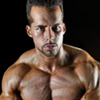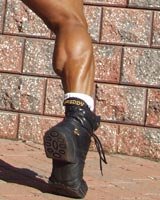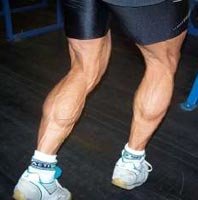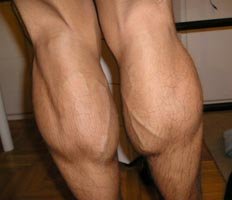
Stubborn Muscle Hypertrophy Workouts
 Table Of Contents:
Table Of Contents:
- Chapter 1 - Introduction
- Chapter 2 - What is Skeletal Muscle Hypertrophy?
- Chapter 3 - Specialized Chest Hypertrophy Workout
- Chapter 4 - Specialized Back Hypertrophy Workout
- Chapter 5 - Specialized Arm Hypertrophy Workout
- Chapter 6 - Specialized Leg Hypertrophy Workout
- Chapter 7 - Specialized Delt & Trap Hypertrophy Workout
- Chapter 8 - Specialized Calf Hypertrophy Workout
- Chapter 9 - Ab Training during a Stubborn Muscle Hypertrophy Routine
- Chapter 10 - Cardio during a Stubborn Muscle Hypertrophy Routine
- Chapter 11 - Nutrition for a Stubborn Muscle Hypertrophy Program
- Chapter 12 - Workout Nutrition/Supplementation
- Chapter 13 - Conclusion

Chapter 8
Specialized Calf Hypertrophy Routine

 Structure & Function: Muscles Of The Lower Leg:
Structure & Function: Muscles Of The Lower Leg:
Before starting on the muscles of the lower leg, there are a few bones that should be known:
- The femur (large bone of the upper leg)
- The tibia (medial, weight bearing bone of the lower leg)
- The fibula (smaller, lateral bone of the lower leg)
- The calcaneus (the "heel" bone)
Each group of lower leg muscles performed as specific task. The anterior muscles are dorsiflexors at the ankle (bringing the top of the foot towards the leg) and extensors of the toes (lifting the toes off the ground). The lateral muscles evert the food (lift the lateral side off the ground).
The posterior muscles are primarily plantar flexors (lift the heel of the foot off of the ground) and flexors of the toes (curl toes). Inversion of the foot (lifting the medial aspect) is accomplished by specific anterior and posterior muscles, which will be discussed individually.
The muscles of the calf (posterior) can be further divided into superficial (near the surface) and deep (near the center) muscles. The superficial muscles include the gastrocnemius, plantaris, and soleus. The deep muscles include the flexor digitorum longus, flexor hallucis longus, and tibialis posterior.
By gaining an understanding of the anatomical structure and function of the muscles of the lower leg, it will become clear as to how to properly exercise and target these muscles. Our discussion of the lower leg muscles with start with the prominent superficial posterior calf muscles.

 Superficial Muscles Of The Calf:
Superficial Muscles Of The Calf: 
Gastrocnemius:
The gastrocnemius is the most prominent and superficial muscle of the calves. This large posterior muscle has two heads: medial and lateral. The medial head of the gastrocnemius originates on the posterior distal femur, near the medial condyle. The lateral head originates on the posterior distal femur, near the lateral condyle.
Both of the heads unite at about midway point of the lower leg into the calcaneal tendon. The calcaneal tendon, commonly referred to as the Achilles tendon, then inserts into the calcanius bone.
The primary function of the gastrocnemius is plantar flexion of the foot. It also assisted in flexing the knee when the leg is not bearing weight. When the leg is bearing weight, flexion cannot occur at the knee unless dorsiflexion at the ankle accompanies it. Therefore, extension of the knee is assisted by the gastrocnemius.
Plantaris:
The plantaris is a small muscle, with a muscle belly only 2-4 inches long, but has a very long tendon. It originates at the lateral epicondyle of the femur, just above the origin of the lateral head of the gastrocnemius. The long tendon of the plantaris passes between the gastrocnemius and soleus and inserts into the calcaneus, anteromedial to the calcaneal tendon.
The plantaris has two functions: assist in knee flexion and ankle plantarflexion. Because of the size and structure of this muscle, these actions are weak. In animals, especially the cat, the plantaris is much larger and inserts onto the bottom of the foot. This setup allows for animals to be able to run faster and jump higher than humans.
Soleus:
The soleus lies deep (right under) to the gastrocnemius. The soleus also has two heads, though not as pronounced as the gastrocnemius' heads. The medial head originates on the posterior tibia and the lateral head on the posterior fibula. These two heads unite and insert into the calcaneal tendon. The primarily function of the soleus is plantar flexion of the foot.
Unlike the gastrocnemius, the soleus does not cross the knee and has no action at that joint. Because of this, when the knee is flexed, the gastrocnemius is at a mechanical disadvantage and the soleus must perform complete plantar flexion.

 Anterior Lower Leg Muscles:
Anterior Lower Leg Muscles:
Tibialis Anterior:
The final muscle of the lower leg we will examine is the tibialis anterior. The tibialis anterior originates at the lateral tibia and interosseous membrane (between tibia and fibula) and inserts on the medial cuneiform and base of 1st metatarsal. The tibialis anterior is a strong invertor and dorsiflexor of the foot.
| CALF ANATOMY Click Text For Info. |
|
|

 Workout A:
Workout A:
- Seated Calf Raise 3 X 4-10
- Standing Calf Raise 3 X 20-40 (Complete 20 reps for the 1st set, decrease load for the 2nd set and do 30 reps, decrease load again for the 3rd set and get 40 reps... it is going to burn!)
- Toes Raises 2 X 8-15
 Click Here For A Printable Log Of Workout A.
Click Here For A Printable Log Of Workout A.

 Workout B:
Workout B:
- Standing Calf Raise 3 X 4-10
- Seated Calf Raise 3 X 20-40 (Complete 20 reps for the 1st set, decrease load for the 2nd set and do 30 reps, decrease load again for the 3rd set and get 40 reps... it is going to burn!)
- Toes Raises 2 X 8-15
 Click Here For A Printable Log Of Workout B.
Click Here For A Printable Log Of Workout B.
If there is one muscle group that is often the most difficult for someone to develop it is the calves. One of the reasons I think the calves are hard to develop is due to improper training of them. By improper training I mean using a poor range of motion (ROM). Often times you will see someone load up the seated calf raise machine and perform calf raises bouncing each rep and using about a 2" ROM.
Now you may look at this program and think "there is nothing special to that." And you would be correct in saying so. The basis of this program is to pound the calves heavily with a heavy weight and low reps then follow that up with HIGH rep sets. The gastrocnemius is targeted more when the knees are straight compared to when flexed while the opposite holds true for the soleus. Here are some simple tips to incorporate with this program to help your calves grow:
- Decrease the weight you use and focus on a full stretch and contraction during EVERY rep
- Do not bounce the weight. Instead pause for 2-3 seconds at the bottom of the movement before beginning the concentric phase of the lift
- Perform for a VARIETY of rep ranges as the calves are composed of both fast-twitch (primarily found in the gastrocnemius) and slow-twitch (primarily found in the soleus) muscle fibers
- Try performing slow eccentrics
- Try performing your calf raises without shoes on
It is easy to become discouraged when it comes to bringing up your calves as they are often the hardest muscle group for people to bring up. It can be done though. Arnold used to try to hide his calves in pictures, sometimes even standing in water. But Arnold brought his calves up and they became one of his best muscle groups. You can do the same if you put forth the effort.

 Specialized Calf Routine Options:
Specialized Calf Routine Options:
Calves Specialization Option #1:
Monday - Calves A + Legs:
Calves
- Seated Calf Raise 3 X 4-10
- Standing Calf Raise 3 X 20-40
- Toe Raises 2 X 8-15
Legs
- Squats 3 X 6-10
- Stiff Leg Deadlift 3 X 6-10
- Leg Extension 3 X 6-10
- Leg Curl 3 X 6-10
 Click Here For A Printable Log Of Monday.
Click Here For A Printable Log Of Monday.
Tuesday - Chest + Delts:
Chest
- Bench Press 3 X 6-10
- Incline DB Press 3 X 6-10
- Dips 3 X 6-10
Delts
- Military or DB Press 3 X 6-10
- DB Side Lateral 3 X 6-10
 Click Here For A Printable Log Of Tuesday.
Click Here For A Printable Log Of Tuesday.
Thursday - Calves B + Bis + Tris:
Calves
- Standing Calf Raise 3 X 4-10
- Seated Calf Raise 3 X 20-40
- Toe Raises 2 X 8-15
Biceps
Triceps
- Close Grip Bench 3 X 6-10
- Skull Crusher 3 X 6-10
 Click Here For A Printable Log Of Thursday.
Click Here For A Printable Log Of Thursday.
Friday - Back + Traps:
Back
- Bent Over Row 3 X 6-10
- Pull-Up or Lat Pulldown 3 X 6-10
- Seated Cable Row 3 X 6-10
Traps






